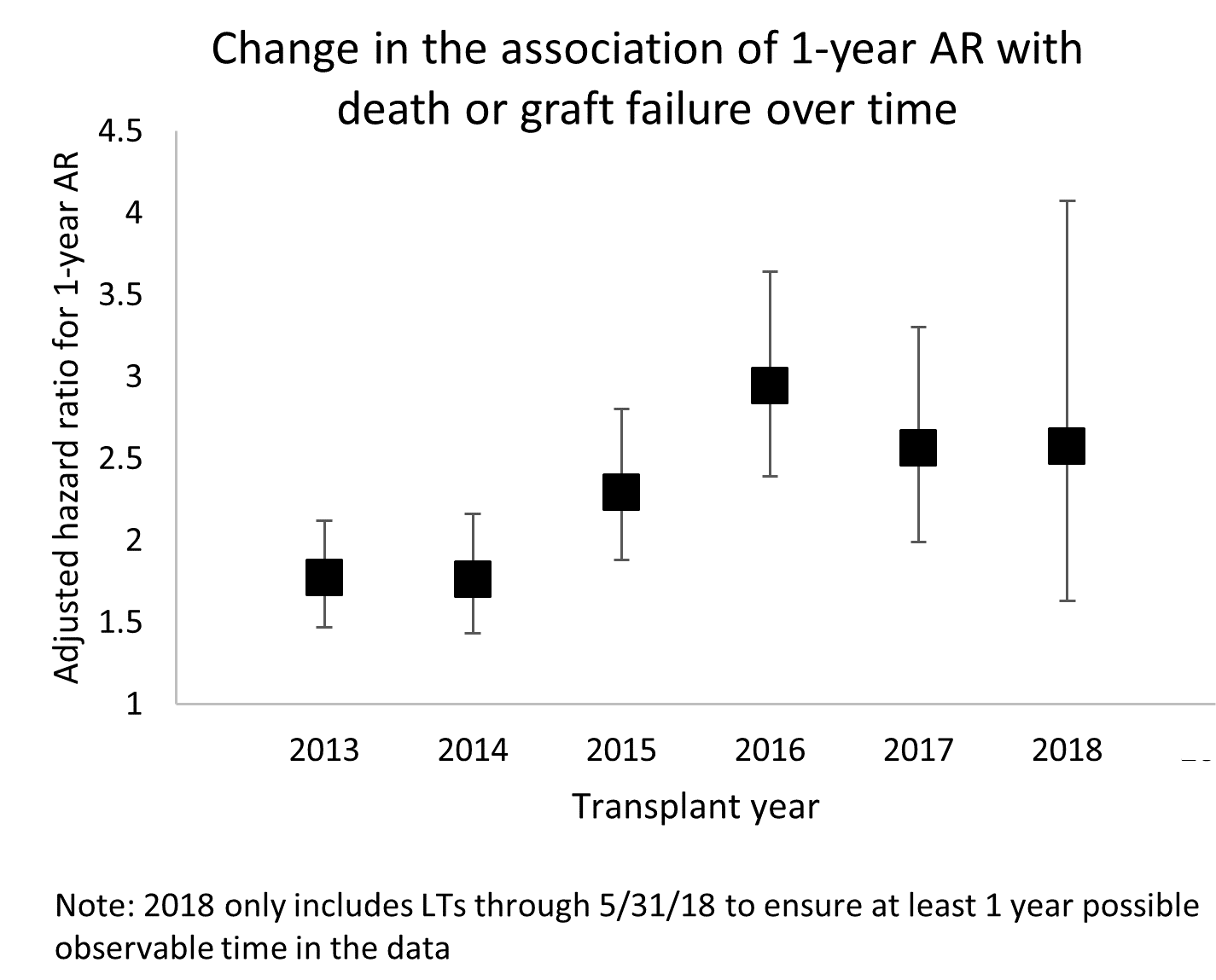Acute Rejection in Liver Transplant Recipients is a Rising Predictor of Death and Graft Failure in the Recent Era of Declining Hepatitis C Virus
1University of Pennsylvania, Philadelphia, PA, 2University of Miami, Miami, FL, 3Northwestern University, Chicago, IL
Meeting: 2020 American Transplant Congress
Abstract number: 152
Keywords: Graft function, Liver grafts
Session Information
Session Name: Liver: Immunosuppression and Rejection
Session Type: Oral Abstract Session
Date: Saturday, May 30, 2020
Session Time: 3:15pm-4:45pm
 Presentation Time: 3:27pm-3:39pm
Presentation Time: 3:27pm-3:39pm
Location: Virtual
*Purpose: Prior to 2013, hepatitis C virus (HCV) played a major role in liver transplant (LT) outcomes, and acute rejection (AR) was found to be a significant predictor of survival in LT recipients (Levitsky, Goldberg, Clin Gast Hep 2017). We sought to determine if this association has persisted in the more recent era of declining recurrent HCV due to successful direct acting antiviral therapy.
*Methods: This was a retrospective cohort study of adult primary LT alone recipients between 1/1/2013-12/31/2018 using the United Network for Organ Sharing database. Cox proportional hazards models were used to investigate 1-year AR as a predictor of death or graft failure. Multivariable models were adjusted for recipient and donor covariates. The interaction of 1-year AR and transplant year was assessed.
*Results: The proportion of LT performed for HCV has decreased sharply from 40.5% in 2013 to 21.3% in 2018 (p<0.001). Though the proportion of recipients experiencing ≥1 episode of AR in the first year has not recently changed (12% in 2013 vs 12.7% in 2018, p=0.2), it is overall lower than in the 2005-2012 era (16.4%; p<0.001 comparing both time periods). In both univariable and multivariable analyses, 1-year AR was a significant predictor of death or graft failure between 2013-2018: hazard ratio (HR) 2.1 (95% confidence interval [CI]: 1.93-2.3, p<0.001) and adjusted HR 1.76 (95% CI: 1.47-2.11, p<0.001). In fact, 1-year rejection was a stronger risk factor for patient/graft survival than either HCV (adjusted HR 1.15, 95% CI: 1.06-1.24; p=0.001) or receipt of an organ donated after circulatory determination of death (adjusted HR 1.45, 95% CI: 1.26-1.66; p<0.001). The interaction of 1-year AR and transplant year was statistically significant (p<0.001). Multivariable models stratified by year revealed an increase in the association of 1-year AR with patient/graft survival over time (Figure).
*Conclusions: 1-year AR remains a leading predictor of death and graft failure in LT recipients and the strength of this association has surprisingly increased in the recent era of direct acting antivirals. While the reasons for this increase need to be determined, AR is a major determinant of patient/graft survival and needs to be minimized to optimize post-LT outcomes.
To cite this abstract in AMA style:
Bittermann T, Goldberg DS, Levitsky J. Acute Rejection in Liver Transplant Recipients is a Rising Predictor of Death and Graft Failure in the Recent Era of Declining Hepatitis C Virus [abstract]. Am J Transplant. 2020; 20 (suppl 3). https://atcmeetingabstracts.com/abstract/acute-rejection-in-liver-transplant-recipients-is-a-rising-predictor-of-death-and-graft-failure-in-the-recent-era-of-declining-hepatitis-c-virus/. Accessed December 14, 2025.« Back to 2020 American Transplant Congress

